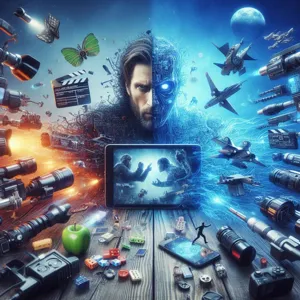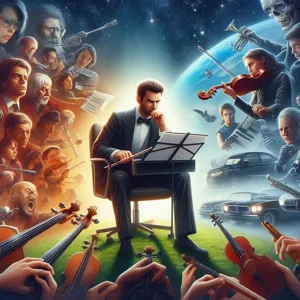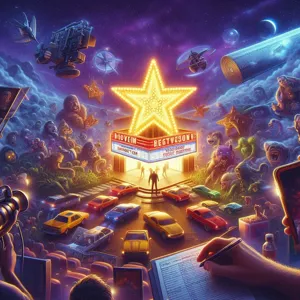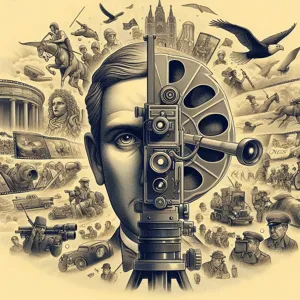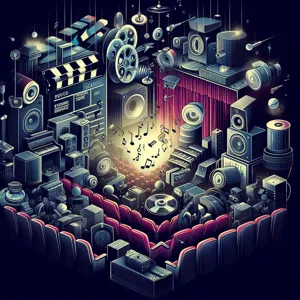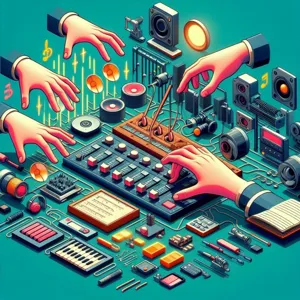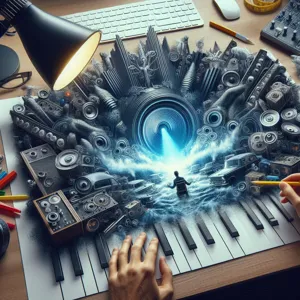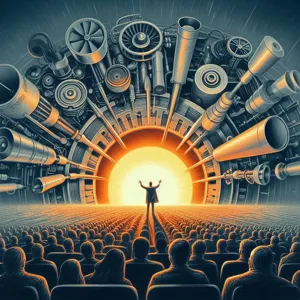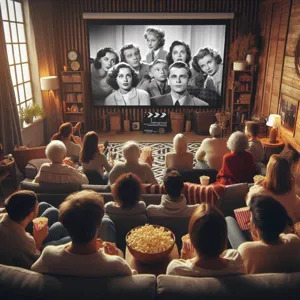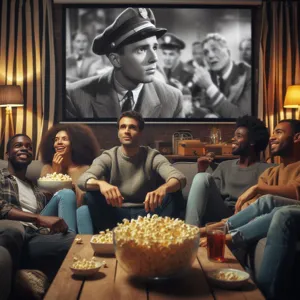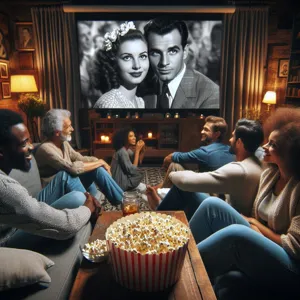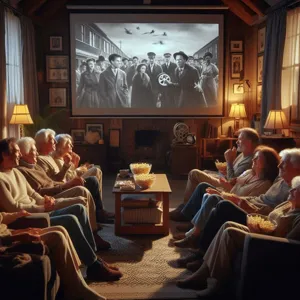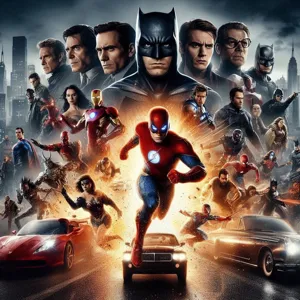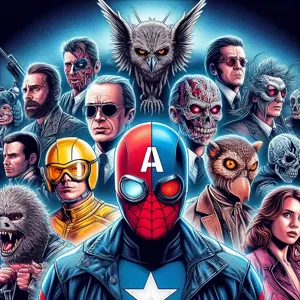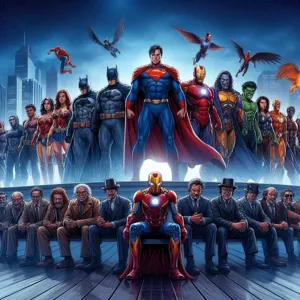In a world where storytelling holds immense power, the realm of filmmaking stands at the crossroads of creativity and ethical responsibility.
As filmmakers strive to capture authentic human experiences and convey thought-provoking narratives, they often grapple with the delicate balance between artistic expression and exploitation. From documentaries that shine a light on marginalized communities to fictional stories that draw inspiration from real-life events, the choices made behind the camera can have profound implications on the subjects portrayed and the audiences who consume these stories. In this blog post, we will explore the complex ethics of filmmaking, examining how creators can navigate the fine line between art and exploitation while fostering a respectful and responsible approach to storytelling. Join us as we delve into the moral dilemmas faced by filmmakers and discuss the importance of integrity in the art of cinema.
1. Introduction to Ethics in Filmmaking

In the realm of filmmaking, where storytelling intertwines with the complexities of human experience, the question of ethics looms large. From the inception of a script to the final cut, filmmakers wield immense power—the ability to shape narratives, evoke emotions, and influence public perception. However, this power comes with a profound responsibility. As artists, filmmakers must navigate a delicate balance between creative expression and ethical considerations, ensuring that their work does not veer into exploitation.
At its core, the ethics of filmmaking encompasses a multitude of factors, including representation, cultural sensitivity, and the treatment of subjects. How filmmakers portray individuals and communities can have lasting impacts, perpetuating stereotypes or fostering understanding. With the rise of documentary filmmaking and the increasing prevalence of real-life stories in cinema, the line between art and exploitation becomes even more pronounced. Filmmakers must ask themselves: Are they honoring the lived experiences of their subjects, or are they simply using their stories as a means to an end?
Moreover, the evolution of technology has introduced new ethical dilemmas, such as the use of deepfakes and manipulated imagery, which can blur the lines of reality and authenticity. In this age of instant content consumption, filmmakers are tasked with the challenge of remaining truthful and respectful while still captivating audiences. As we delve deeper into the ethics of filmmaking, it becomes clear that the choices made behind the camera resonate far beyond the screen, shaping societal narratives and influencing cultural dialogues.
In this blog post, we will explore the various ethical dilemmas faced by filmmakers, examining case studies and drawing from industry insights to shed light on how to navigate the fine line between artistic vision and ethical responsibility. Through thoughtful reflection and open dialogue, we can foster a filmmaking landscape that honors both creativity and conscience, ensuring that stories are told with integrity and respect.
2. The Role of Documentary Filmmaking: Truth vs. Exploitation
Documentary filmmaking holds a unique position in the pantheon of cinematic expression, serving as both a powerful medium for storytelling and a potential tool for exploitation. At its core, documentary film aims to illuminate reality, capturing the nuances of life, culture, and human experience. However, this noble pursuit can sometimes blur the lines between truth and exploitation, raising ethical concerns that filmmakers must navigate with care.
In crafting a documentary, filmmakers often wrestle with the responsibility of portraying their subjects authentically while also delivering a compelling narrative. This balancing act can lead to difficult decisions about what to include, what to exclude, and how to present the material. For instance, documenting sensitive issues, such as poverty, trauma, or social injustice, necessitates a careful approach to ensure that the representation of individuals or communities is respectful and not sensationalized for dramatic effect. Exploiting the struggles of marginalized groups for the sake of entertainment or shock value not only undermines the integrity of the documentary but also perpetuates harmful stereotypes.
Moreover, the dynamics of power play a significant role in this equation. Often, filmmakers come from privileged backgrounds, wielding the camera as a tool to depict the lives of those who may not have a voice in the mainstream media. This raises questions about agency and consent—are the subjects of the film adequately informed and empowered in the process? Ethical documentary filmmakers strive to foster collaboration with their subjects, ensuring that their stories are told with dignity and respect, rather than being reduced to mere spectacle.
Ultimately, the role of documentary filmmaking is to shine a light on the truth, fostering understanding and empathy among audiences. Yet, as filmmakers continue to explore the depths of human experience, they must remain vigilant, mindful of the fine line they tread between illuminating reality and exploiting it for personal gain. By prioritizing ethical considerations in their storytelling, documentary filmmakers can create impactful works that resonate with viewers while honoring the humanity of those they depict.
3. Depicting Sensitive Subjects: Ethical Considerations

When it comes to filmmaking, the choice to depict sensitive subjects is a significant responsibility that demands careful consideration and ethical foresight. Sensitive topics, whether they involve personal trauma, social injustice, or cultural heritage, have the potential to evoke profound emotional responses, but they also carry the risk of exploitation if not handled appropriately. Filmmakers must navigate this delicate terrain with a blend of empathy, respect, and authenticity.
First and foremost, it is essential to approach sensitive subjects with a commitment to thorough research and an understanding of the lived experiences of those affected. This involves listening to the voices of individuals and communities that the film aims to represent. Engaging with these perspectives not only enriches the narrative but also helps avoid perpetuating stereotypes or misrepresentations that can further marginalize already vulnerable groups.
Moreover, filmmakers should ask themselves critical questions about their motivations and the implications of their storytelling. Are they amplifying voices that need to be heard, or are they merely exploiting trauma for entertainment value? The key lies in ensuring that the portrayal serves a purpose beyond sensationalism; it should contribute to awareness, understanding, and ultimately, social change.
Consent and representation are also paramount. When working with real-life stories, especially those involving personal or collective trauma, obtaining informed consent from the individuals involved is not just a legal formality, but a moral obligation. Filmmakers must consider how their depiction may affect the subjects, acknowledging that their stories are not just plot points, but real-life experiences that deserve dignity and respect.
Lastly, the ethical implications extend beyond the screen. Filmmakers should consider how their work will be received by audiences and the potential for triggering reactions or perpetuating harmful narratives. By prioritizing sensitivity and ethical accountability, filmmakers can create impactful works that honor the complexities of human experience while fostering a culture of empathy and understanding. In this way, the art of filmmaking can transcend the boundaries of entertainment, becoming a powerful tool for social dialogue and transformation.
4. The Impact of Filmmaking on Vulnerable Communities
Filmmaking possesses an extraordinary power to tell stories and evoke emotions, yet it also carries a profound responsibility, especially when it comes to portraying vulnerable communities. This delicate balance between art and exploitation is under constant scrutiny, as filmmakers must navigate the ethical implications of their work. The impact of filmmaking on these communities can be both transformative and damaging, depending on how stories are told and whose voices are amplified.
When filmmakers choose to represent marginalized groups, they hold the potential to shed light on pressing social issues, challenge stereotypes, and foster empathy among broader audiences. Documentaries that highlight the struggles of indigenous peoples, for instance, can serve as powerful advocacy tools, raising awareness and inspiring action towards social justice. However, this is only effective when the narratives are crafted with care, respect, and genuine collaboration with the communities being depicted.
On the flip side, there lies a risk of exploitation, where the very act of storytelling can inadvertently commodify the experiences of the vulnerable. Sensationalized portrayals may reduce complex lives into mere spectacle, stripping individuals of their dignity and agency. Filmmakers must be vigilant, ensuring that they do not extract stories from these communities for profit or acclaim without giving something back in return. This includes financial compensation, community engagement, and, most importantly, giving those within the community a platform to tell their own stories.
Moreover, it is crucial for filmmakers to engage in meaningful dialogue with community members throughout the filmmaking process. This collaboration not only enriches the narrative but also empowers those being portrayed, ensuring their voices are heard and respected. By prioritizing ethical considerations and fostering genuine partnerships, filmmakers can create works that resonate deeply and drive positive change, rather than perpetuating cycles of marginalization.
Ultimately, the impact of filmmaking on vulnerable communities relies heavily on the intent and integrity of the storyteller. By recognizing the power dynamics at play and striving to act ethically, filmmakers can navigate the fine line between art and exploitation, creating works that uplift and honor the diverse tapestry of human experience.
5. Consent and Representation: Navigating Ethical Boundaries

In the realm of filmmaking, the concepts of consent and representation are crucial ethical considerations that can significantly impact both the integrity of a project and the lives of those depicted within it. As filmmakers, it is essential to approach these aspects with sensitivity and respect, recognizing the power of visual storytelling to shape perceptions and influence societal narratives.
Consent goes beyond simply obtaining permission to film; it involves a deeper commitment to ensuring that all participants are fully aware of how their stories will be portrayed. This is particularly important when working with marginalized communities or individuals who may not have the same level of agency as others. Filmmakers must engage in open dialogues, allowing subjects to express their comfort levels and boundaries. This ensures that their voices are authentically represented, rather than manipulated for dramatic effect or sensationalism.
Representation is equally vital. The on-screen depiction of individuals should reflect their multifaceted identities, avoiding harmful stereotypes that can perpetuate societal biases. Filmmakers have a responsibility to portray characters and communities in a way that honors their lived experiences and complexities. This means conducting thorough research, collaborating with cultural consultants, and, when possible, including members of the communities being represented in the creative process.
By prioritizing consent and representation, filmmakers can navigate the fine line between artistic expression and exploitation. This ethical approach not only fosters trust and collaboration but also enriches the narrative, creating films that resonate more profoundly with audiences while holding true to their moral obligations. In an era where audiences are increasingly aware and critical of the media they consume, filmmakers must strive to create art that uplifts, educates, and respects the stories of those they depict.
6. Cultural Appropriation in Film: What You Need to Know
Cultural appropriation in film is a complex and often contentious issue that filmmakers must navigate with care and sensitivity. At its core, cultural appropriation occurs when individuals or groups borrow elements from a culture, often without understanding or respecting the original context, leading to misrepresentation or commodification. In the realm of filmmaking, this can manifest in various ways — from casting decisions and storylines to the portrayal of cultural practices and traditions.
As filmmakers, it’s essential to recognize the power dynamics at play. When a dominant culture appropriates aspects of a marginalized culture, it can reinforce stereotypes, perpetuate misconceptions, and strip meaning from culturally significant practices. For instance, a film that portrays a particular culture solely through the lens of exoticism or sensationalism can do a disservice to the people it seeks to represent, reducing their rich histories and experiences to mere entertainment.
To navigate this fine line, filmmakers should prioritize authenticity and representation. This involves engaging with cultural consultants, collaborating with individuals from the culture being portrayed, and doing thorough research to ensure that the narratives being told are accurate and respectful. It’s crucial to give voice to those whose stories are being depicted, allowing them to share their experiences and perspectives rather than relying on external interpretations that may lack nuance.
Moreover, filmmakers must be willing to engage in self-reflection and acknowledge the potential impact of their work. This means being open to feedback and criticism from the communities being represented and taking responsibility for the stories they tell. Ultimately, the goal should be to foster understanding and appreciation rather than exploitation, creating films that celebrate diversity and promote dialogue rather than division. By approaching cultural representation with integrity and respect, filmmakers can contribute to a more inclusive and ethical cinematic landscape.
7. The Responsibility of Filmmakers to Their Subjects

In the realm of filmmaking, the relationship between filmmakers and their subjects is a delicate dance, steeped in ethical considerations that demand careful navigation. Filmmakers hold a profound responsibility to the people they portray, especially when those individuals are vulnerable or marginalized. This responsibility goes beyond mere representation; it encompasses respect, empathy, and a commitment to presenting subjects authentically and humanely.
At its core, this responsibility involves obtaining informed consent. Filmmakers must ensure that their subjects fully understand the implications of their participation, including how their stories will be told and showcased. This is particularly crucial in documentaries or narrative films that delve into sensitive topics, as the subjects’ lives may be laid bare for public scrutiny. Failing to secure genuine consent not only undermines the integrity of the film but can also lead to emotional and psychological harm to those involved.
Moreover, filmmakers must strive to portray their subjects with nuance and depth, avoiding stereotypes and one-dimensional narratives. This requires diligent research, open dialogue, and a willingness to listen. By engaging with their subjects and allowing them to share their stories in their own words, filmmakers can create a more authentic representation that highlights the complexities of the human experience.
Additionally, there is an ethical obligation to consider the potential impact of the film on its subjects and their communities. Filmmakers should reflect on how their work might influence public perception and discourse around the issues being depicted. Will it empower the subjects, or could it perpetuate stigma and exploitation? This level of introspection is vital in ensuring that the art of filmmaking does not overshadow the well-being of those whose lives are being documented.
Ultimately, the responsibility of filmmakers to their subjects is about fostering a relationship built on trust and mutual respect. By prioritizing ethical considerations, filmmakers can create impactful stories that resonate with audiences while honoring the dignity of those who share their truths. In doing so, they contribute to a filmmaking landscape that is not only artistically rich but also socially conscious and ethically sound.
8. Profit vs. Purpose: The Commercialization of Storytelling
In the ever-evolving landscape of filmmaking, the tension between profit and purpose stands as a formidable challenge for creators. The commercialization of storytelling has transformed the medium from a purely artistic endeavor into a lucrative industry driven by box office successes and streaming algorithms. As filmmakers navigate this intricate terrain, they must grapple with the ethical implications of their choices.
On one hand, the pursuit of profit can lead to stories that resonate with wide audiences, resulting in financial success and the potential for funding future projects. Blockbusters often prioritize broad appeal, sometimes at the expense of depth and authenticity. This can manifest in formulaic narratives or the over-simplification of complex social issues, as filmmakers lean on familiar tropes to ensure maximum box office appeal.
On the other hand, there exists a profound purpose behind storytelling—an opportunity to challenge societal norms, give voice to the marginalized, and provoke thought and discussion. Filmmakers who prioritize purpose often find themselves at odds with commercial pressures, facing tough decisions about whether to compromise their vision to secure funding or distribution deals. The risk is that in seeking profits, the integrity of the narrative can become diluted, leading to exploitation rather than empowerment.
This delicate balancing act raises critical questions: How can filmmakers honor their artistic vision while still engaging with the commercial aspects of the industry? Are there ways to create financially successful projects that remain true to meaningful storytelling? As audiences become increasingly aware of the narratives being presented to them, filmmakers must critically assess their motivations and the potential impact of their work. In an age where streaming platforms and social media amplify every voice, the responsibility to navigate the fine line between profit and purpose has never been more crucial. Ultimately, the challenge lies in crafting stories that not only entertain but also enlighten, ensuring that the heart of filmmaking remains anchored in the values of empathy and authenticity.
9. Case Studies: Notable Ethical Dilemmas in Film History
### Case Studies: Notable Ethical Dilemmas in Film History
Throughout the annals of cinema, filmmakers have faced numerous ethical dilemmas that not only challenge their artistic integrity but also raise questions about the morality of their choices. These instances serve as cautionary tales and insightful studies into the complex relationship between art and exploitation.
One of the most infamous examples is the 1972 film *The Last House on the Left*, directed by Wes Craven. This horror film, inspired by Ingmar Bergman’s *The Virgin Spring*, plunged audiences into a harrowing narrative of violence and revenge. Craven’s decision to portray graphic violence was not merely for shock value; he aimed to comment on the brutality of human nature. However, the film’s raw depiction of sexual assault and murder sparked intense debates about the ethical responsibility of filmmakers to their subjects and audiences alike. Critics questioned whether such representations desensitize viewers or trivialize the severe realities of violence against women.
Another compelling case is *The Act of Killing* (2012), directed by Joshua Oppenheimer. This documentary challenges former Indonesian death squad leaders to reenact their real-life atrocities in any cinematic genre they choose. The ethical dilemma here lies in the power dynamics and the potential for glorification of violence. While the film sheds light on a dark chapter in history, it raises concerns about whether giving these perpetrators a platform inadvertently romanticizes their actions. The film compels viewers to grapple with the uncomfortable question: can art serve as a medium for accountability, or does it risk becoming entertainment at the expense of truth?
Similarly, the production of *Bird Box* (2018) ignited ethical discussions surrounding mental health portrayals in film. While the film received acclaim for its gripping narrative and suspense, it faced backlash for its depiction of trauma and survival. Critics argued that the film’s representation of mental illness could reinforce stigmas and misinform audiences about the complexities of psychological conditions. Filmmakers must navigate these sensitive topics with care, ensuring that they depict struggles authentically without reducing them to mere plot devices.
These case studies illustrate the ongoing tension within the filmmaking community between artistic expression and ethical responsibility. As creators continue to explore challenging themes, they must remain vigilant about the potential consequences of their work. By examining past dilemmas, filmmakers can better navigate the fine line between art and exploitation, striving to produce content that enlightens rather than harms. As audience members, it’s equally important for us to engage critically with the films we consume, recognizing the ethical implications behind the stories portrayed on screen.
10. Balancing Artistic Freedom and Ethical Responsibility
In the world of filmmaking, the quest for artistic expression often dances on a precarious edge, where creativity meets ethical responsibility. Directors, screenwriters, and producers are faced with the challenge of how to tell their stories authentically without crossing into exploitation. Balancing these two forces requires a nuanced understanding of the impact their narratives have on audiences, subjects, and society at large.
Artistic freedom allows filmmakers to push boundaries, explore complex themes, and challenge societal norms. However, this freedom comes with the weighty responsibility of ensuring that the stories told do not perpetuate harm or injustice, particularly when they involve marginalized communities or sensitive subjects. It is essential for filmmakers to engage in thorough research, consult with experts, and, where possible, involve the communities represented in their films in the creative process. This collaborative approach not only enriches the storytelling but also helps to safeguard against misrepresentations and stereotypes.
Moreover, filmmakers must grapple with the implications of their choices in casting, narrative framing, and visual representation. Are they celebrating diversity and authenticity, or are they commodifying pain and suffering for the sake of entertainment? The line between compelling storytelling and exploitation can sometimes blur, leading to significant ethical dilemmas. It is crucial for filmmakers to continuously reflect on their intentions and the consequences of their narratives, striving for a balance that honors both their artistic vision and the dignity of their subjects.
Ultimately, the journey of balancing artistic freedom and ethical responsibility is an ongoing dialogue within the film industry. By prioritizing empathy and social consciousness in their work, filmmakers can create impactful stories that resonate with audiences while fostering a culture of respect and integrity in the art they love.
11. The Role of Audience Perspective in Ethical Filmmaking
In the realm of filmmaking, the audience’s perspective plays a pivotal role in shaping the ethical considerations behind a project. Filmmakers are not just creators; they are storytellers who must navigate the delicate balance between artistic expression and the potential impact of their narratives on viewers. Understanding how audiences perceive and interpret content is essential—what may be a thought-provoking representation for one viewer could easily be seen as exploitative or harmful by another.
Audience perspective is influenced by myriad factors, including cultural background, personal experiences, and societal norms. Filmmakers often grapple with how to authentically portray sensitive subjects, particularly those involving marginalized communities or traumatic events. They must ask themselves: Does the film amplify voices that are often silenced, or does it merely exploit their stories for sensationalism? Are the characters fully developed, or are they reduced to stereotypes that reinforce harmful narratives?
Engaging with the audience does not end with the release of the film; it extends into the conversations that follow. Filmmakers can actively seek feedback from diverse viewing groups, creating forums for discussion and dialogue that help them understand the ramifications of their work. By fostering an open line of communication, filmmakers can gain insight into the lived experiences of their audience, which can inform their future projects and improve their ethical considerations.
Ultimately, the role of audience perspective in ethical filmmaking is a powerful reminder that art does not exist in a vacuum. It is a reflection of society, a catalyst for change, and, at times, a mirror that reveals uncomfortable truths. By being attuned to how their work resonates with viewers, filmmakers can strive to create narratives that respect and elevate rather than exploit or diminish. This mindful approach not only cultivates a deeper connection with the audience but also fosters a more just and compassionate cinematic landscape.
12. Best Practices for Ethical Filmmaking
In the ever-evolving landscape of cinema, ethical filmmaking has emerged as a critical consideration for creators who wish to navigate the complex interplay between artistic expression and social responsibility. Adhering to best practices in ethical filmmaking not only elevates the integrity of a project but also fosters trust and respect within the communities and individuals involved. Here are some key strategies to ensure that your filmmaking process aligns with ethical standards.
**1. Prioritize Transparency:** Open communication is vital from pre-production through post-release. Engage with participants, crew members, and communities to ensure that they understand the project’s intentions, methods, and potential impacts. A transparent approach cultivates trust and mitigates misconceptions.
**2. Obtain Informed Consent:** Whether working with actors or real-life subjects, it is essential to obtain informed consent. This means providing clear information about how their contributions will be used, the potential risks involved, and their right to withdraw at any point. Respecting autonomy is fundamental to ethical filmmaking.
**3. Represent Diversity Accurately:** Films have the power to shape perceptions and narratives. Strive for authenticity by representing diverse voices and perspectives accurately. This requires diligent research and collaboration with individuals from those communities to avoid cultural appropriation and misrepresentation.
**4. Consider the Impact:** Reflect on the potential consequences of your film on individuals and communities. Ask critical questions: Will it perpetuate stereotypes? Will it exploit vulnerable populations? Be mindful of the broader societal implications of your narrative choices.
**5. Create a Safe Work Environment:** The wellbeing of your cast and crew is paramount. Establish a safe, inclusive, and respectful work environment that encourages open dialogue about boundaries and concerns. Implementing policies against harassment and discrimination is crucial for fostering a positive atmosphere.
**6. Engage in Responsible Storytelling:** Every story has a unique context. Be diligent in understanding the historical, cultural, and social backgrounds of the subjects you are portraying. Approach sensitive topics with care, ensuring that the narrative does justice to the experiences being represented rather than sensationalizing them for entertainment.
**7. Support Fair Compensation:** Fair compensation for all participants, including crew, actors, and contributors, is an ethical obligation. Ensure that individuals are paid fairly for their time, skills, and contributions to the project, recognizing their value within the creative process.
By integrating these best practices into your filmmaking process, you not only enhance the quality and authenticity of your projects but also contribute to a more ethical and responsible film industry. In a world where storytelling holds immense power, filmmakers have a profound responsibility to use their craft wisely, promoting understanding and empathy while steering clear of exploitation.
13. How Technology Affects Ethical Considerations in Film
In today’s rapidly evolving cinematic landscape, technology plays a pivotal role in shaping ethical considerations in filmmaking. The advent of advanced digital tools, high-resolution cameras, and sophisticated editing software has democratized the art of filmmaking, enabling aspiring filmmakers to tell their stories with unprecedented ease and creativity. However, this accessibility also raises significant ethical dilemmas that creators must navigate.
For instance, the proliferation of social media and streaming platforms has transformed how films reach audiences. While this opens doors for diverse voices and underrepresented narratives, it also poses the risk of sensationalism. Filmmakers may feel pressured to prioritize clickbait-style content over authentic storytelling to capture viewer attention in an oversaturated market. This shift can lead to the exploitation of sensitive subjects or marginalized communities, as filmmakers might exploit their stories for shock value or virality rather than genuine representation.
Moreover, the rise of artificial intelligence in filmmaking introduces another layer of complexity. AI tools can assist in scriptwriting, casting, and even generating visual effects, but their use raises questions about authorship and originality. As filmmakers leverage AI-generated content, the line between creativity and imitation blurs, leading to ethical concerns around intellectual property and the potential erasure of human artistry.
Additionally, the ease of capturing and sharing footage has heightened the responsibility filmmakers have towards their subjects. With the ability to document real-life events at any moment, filmmakers must consider the implications of their work on the individuals involved. Ethical considerations regarding consent, privacy, and the potential for harm are more crucial than ever. In a world where footage can go viral in an instant, ensuring that subjects are portrayed with dignity and respect is paramount.
As filmmakers harness the power of technology to tell their stories, they must remain vigilant and reflective about the ethical implications of their choices. By prioritizing integrity and responsibility, filmmakers can navigate the intricate balance between artistic expression and the potential for exploitation, ultimately fostering a film industry that respects and uplifts all voices.
14. The Future of Ethical Filmmaking in a Globalized World
As the landscape of filmmaking continues to evolve in our increasingly interconnected world, the future of ethical filmmaking is poised at a pivotal crossroads. Globalization brings with it a rich array of stories, cultures, and perspectives that filmmakers can draw upon, yet it also raises critical questions about representation, authenticity, and the potential for exploitation. The democratization of film through technology has empowered diverse voices to share their narratives, but it has also led to a proliferation of content that can sometimes overlook the ethical responsibilities that come with storytelling.
In this new era, filmmakers must grapple with the implications of their choices. With audiences more aware and sensitive to issues of cultural appropriation and misrepresentation, filmmakers are challenged to engage deeply with the communities they depict. This requires not only collaboration with local artists and storytellers but also a commitment to ensuring that the narratives presented are grounded in truth and mutual respect. Ethical filmmaking demands sensitivity to the power dynamics at play, particularly when telling stories from marginalized communities.
Moreover, as the industry becomes more global, filmmakers must navigate complex cultural norms and values, which can vary dramatically from one region to another. This necessitates a nuanced approach to storytelling, where filmmakers actively seek to understand the cultural context behind their subjects. It’s essential to foster dialogue and collaboration, allowing those whose stories are being told to have a voice in the process, thereby promoting an authentic and respectful representation.
The future of ethical filmmaking will also be influenced by technological advancements. With tools like virtual reality and artificial intelligence transforming how stories are told, filmmakers have the opportunity to create immersive experiences that can foster empathy and understanding. However, these advancements come with their own ethical considerations, particularly regarding privacy, consent, and the potential for manipulation.
Ultimately, as we look to the future, the key to ethical filmmaking lies in a commitment to continuous learning and reflection. Filmmakers must be willing to question their own biases and assumptions, actively seek feedback from diverse communities, and prioritize the dignity and rights of their subjects. By doing so, they can navigate the fine line between art and exploitation, creating films that not only entertain but also enlighten and empower audiences around the globe. The responsibility is immense, but the potential for positive impact is even greater—transforming the way we share stories in a globalized world.
15. Conclusion: Striving for Integrity in the Art of Filmmaking
As we draw this exploration of the ethics of filmmaking to a close, it’s crucial to reflect on the responsibility that comes with wielding the power of storytelling. Filmmaking is an art that possesses the unique capacity to shape perceptions, evoke emotions, and influence societal narratives. Yet, with this power comes the potential for exploitation, misrepresentation, and harm. Striving for integrity in the art of filmmaking is not just a noble ideal; it is a necessity in an industry that has historically grappled with moral dilemmas.
To navigate the fine line between artistic expression and ethical responsibility, filmmakers must cultivate a deep sense of awareness about the subjects they portray. This involves not only doing thorough research and understanding the nuances of the stories they wish to tell but also actively engaging with the communities and individuals involved. Authentic representation and a commitment to honoring diverse perspectives can transform a film from mere entertainment into a meaningful commentary that resonates with audiences on a deeper level.
Moreover, filmmakers must challenge themselves to question their motivations and the implications of their work. Are they prioritizing sensationalism over truth? Are they amplifying voices that deserve to be heard, or are they overshadowing them in pursuit of profit? By fostering open dialogues within their teams and seeking feedback from marginalized voices, filmmakers can create a culture of accountability that enriches their projects and enhances their ethical standards.
Ultimately, striving for integrity in filmmaking means embracing vulnerability—acknowledging that art can both uplift and exploit, educate and mislead. As the industry continues to evolve, filmmakers must remain steadfast in their commitment to ethical storytelling, ensuring that their artistic visions contribute positively to the world. In doing so, they not only honor their craft but also pave the way for a more inclusive and responsible cinematic landscape. The call to create ethically is not just a trend; it is a movement towards a future where art and conscience coexist harmoniously, leaving a lasting impact on audiences and society as a whole.
In conclusion, the world of filmmaking is a complex tapestry woven with creativity, ethics, and responsibility. As we’ve explored throughout this article, navigating the fine line between artistic expression and exploitation requires a deep understanding of the implications of our choices as filmmakers. From representing diverse stories authentically to ensuring the well-being of those involved in the production, each decision carries weight that can impact lives and communities. By fostering a culture of respect and accountability, filmmakers can create art that not only resonates with audiences but also uplifts and honors those whose stories are being told. As you embark on your filmmaking journey, we encourage you to reflect on these ethical considerations and engage in conversations that challenge you to think critically about the impact of your work. Let us strive to create films that inspire, provoke thought, and ultimately contribute positively to the world around us.






